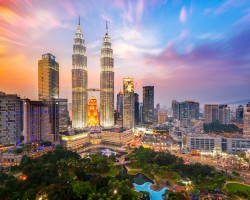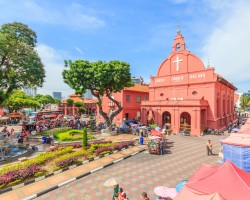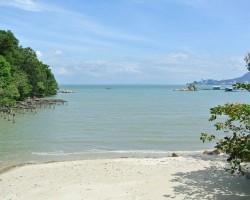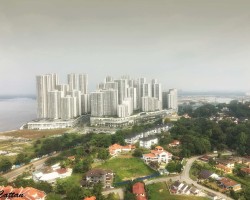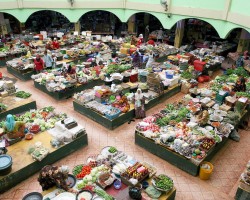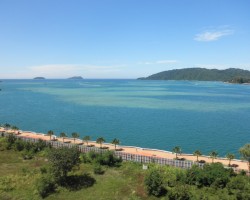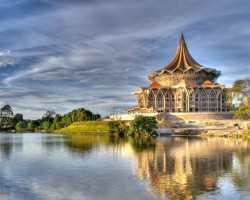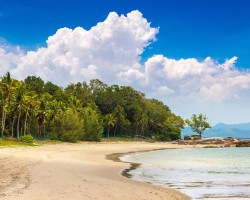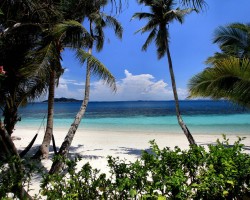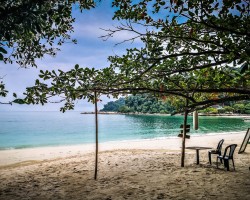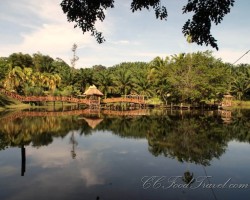Best time to go to Malaysia for a perfect weather and where to go?
When is the best time to go to Malaysia?
The climate of Malaysia is dominated by the omnipresence of rain. Additionally, the influence of monsoons and the country's geography result in significant climate diversities across regions. Therefore, it is important to stay informed about local weather conditions before planning a trip to Malaysia. Surprisingly, the best time to visit Malaysia is not when the weather is most favorable. Indeed, the peak tourist season extends from December to February. These months coincide with school holidays in Malaysia and important cultural events such as Chinese New Year, attracting many travelers. Consequently, flight and hotel prices tend to increase. It is advisable to book your trip several months in advance. However, for visiting Malaysia under favorable weather conditions, it is better to opt for the end of the winter monsoon and the month of February, which is often less rainy. This is particularly true if you plan to stay in Kuala Lumpur. On the other hand, if you are wondering when to visit Malaysia to avoid crowds, it is preferable to choose the low season, which runs from March to September. Moreover, on the west coast, rainfall is often lower from June to September, which is ideal for a beach holiday. In general, it is best to avoid traveling to Malaysia between November and December when the rains can be torrential, especially in the eastern part of the country.
Where and when to go based on the weather?
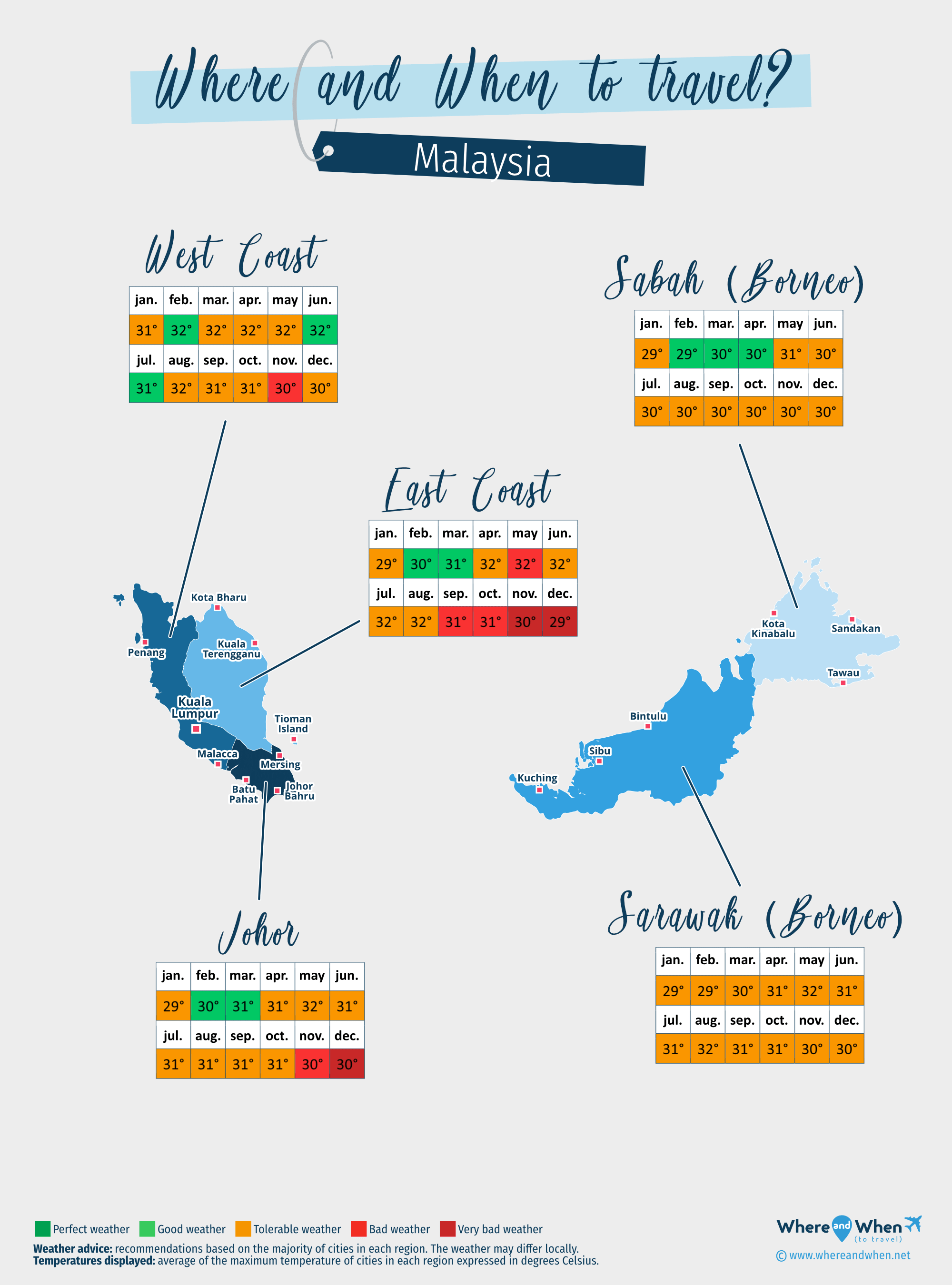
East Coast of Malaysia
Tioman Island, Kota Bharu, Kuala Terengganu...
Johor
Johor Bahru, Mersing, Batu Pahat...
Sabah (Borneo)
Kota Kinabalu, Sandakan, Tawau...
Sarawak (Borneo)
Kuching, Sibu, Bintulu...
West Coast of Malaysia
Kuala Lumpur, Penang, Malacca...
To get all the information about the climate and weather in Malaysia for a specific month, click on the corresponding link below:
Malaysia in january Malaysia in february Malaysia in march Malaysia in april Malaysia in may Malaysia in june Malaysia in july Malaysia in august Malaysia in september Malaysia in october Malaysia in november Malaysia in december
Best time to travel to Malaysia by cities
Climate and Weather in Malaysia
Located between Thailand, Indonesia, the Philippines, and Singapore, at the heart of Asia, Malaysia is a country with a peculiar bicameral geography. Indeed, we find:
- one part of the country extending from Thailand
- and the other part on Borneo Island
This country has an equatorial climate. Thus, the weather in Malaysia is characterized by constant heat and humidity. Due to its location, Malaysia is also subject to two monsoon seasons, in the northeast and southwest. Except for the highlands, it is difficult to find some coolness in this country.
It is impossible to give a "typical climate" in Malaysia, or even to accurately determine the best time to visit. Indeed, Malaysia is subject to numerous microclimates.
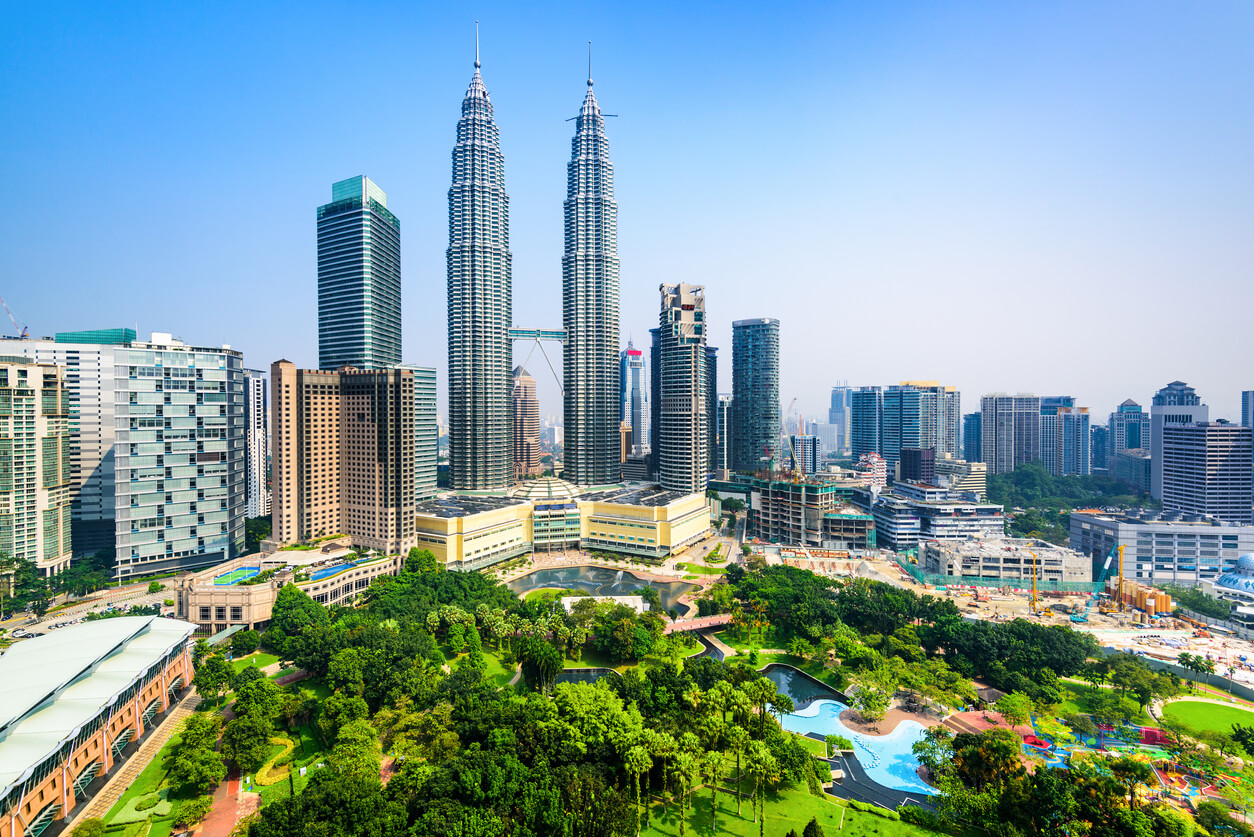
Climate on the East Coast of the Peninsula
The east coast of peninsular Malaysia experiences heavy rainfall during the winter monsoon. Indeed, from November to March, the northeast monsoon brings very intense rains. For example, more than 600 mm of precipitation can fall in December in Kuala Terengganu.
In this region, November and December are particularly unfavorable in terms of climate. In Pulau Aur, for instance, the rains can be torrential and the sky is often cloudy during this period.
The temperature remains stable throughout the year, hovering around 30°C (86°F) .
The ideal time to visit this region is after the winter monsoon, during the months of February to April. This period is relatively dry and sunny. Afterwards, precipitation tends to increase from May onwards.
Some areas have a more temperate climate, such as Bandar Penawar, where the weather is favorable all year round.
Climate of Eastern Malaysia (Borneo)
This region, located on the island of Borneo, includes the states of Sabah, Sarawak, and the federal territory of Labuan.
It is subject to the winter monsoon. Therefore, precipitation is generally more abundant in this area from November to February. For example, in Sandakan, it rains nearly 500 mm in January alone.
On the other hand, the months from April to September are often the most favorable in terms of climate. For example, in Kuching, it rains "only" about 15 days per month but in small quantities.
However, in the Gunung Mulu National Park, the period from April to September sees an increase in precipitation with notably over 400 mm of rain per month in April-May.
On-site, the temperature varies little throughout the year: averaging between 27 and 34°C (94°F) . There is a slight decrease in temperatures between January and March and a slight increase in May and June.
Finally, it should be noted that Eastern Malaysia has a more pleasant climate. This is the case in Pulau Sipadan, which receives less than 100 mm of rain per month all year round. Moreover, in Kudat, in the northeast, the weather is relatively dry and sunny all year round. Only the months of November and December should be avoided.
Climate on the West Coast of Malaysia
In this region, protected by mountains, rainfall is less abundant than in the rest of Malaysia. Moreover, it is relatively spared from the northeast monsoon. In this area, the months from November to March are not always the rainiest, especially in the northwest, like in George Town.
On the other hand, rainfall tends to be fairly consistent throughout the year. In Kuala Lumpur, for example, it rains between 100 and 250 mm every month. There is a decrease in precipitation in February and between June and September.
Indeed, from late May to September, the southwest monsoon, or summer monsoon, brings strong winds. Thus, precipitation decreases and the weather becomes sunnier. This is notably the case in Johor Bahru, where it rains less than 100 mm per month in summer.
Finally, one should be cautious of particularly violent gusts of wind that accompany the summer monsoon. These are also known as "Sumatra squalls."
Climate of the Malaysian Coasts
The climate of Malaysia gets a bit of freshness on the coasts due to the influence of the ocean. Sunnier and windier, these areas have a more bearable atmosphere for travelers. Thus, they attract a large number of tourists, especially to enjoy the country's beaches.
Climate in the Inland Regions
In the inland region of Malaysia, such as in Raub, the heat is particularly stifling. Humidity is high throughout the year, and it is very difficult to bear the particularly heavy atmosphere. Thus, this region is relatively less frequented by tourists.
Temperatures and rainfall in Malaysia
On these 3 graphs, we present the evolution of temperatures of Malaysia and month-by-month rainfall for the cities of Kuala Lumpur, Malacca, Penang, Batu Pahat and Bintulu, as well as the month-by-month sea temperature for coastal cities.
Peak visitor numbers and tourist seasons in Malaysia
Find out when Malaysia has its high tourist season (the period when the influx of tourists is highest) and off-peak tourist season using our data and figures.
Tourist seasons in Malaysia
The months with low numbers of tourists are: January, February, March, April, May, June, September, October and November. The number of visitors to Malaysia is high in: July, August and December.
- Very low season in Malaysia: January, February, March, April, May, June, September, October and November.
- High season in Malaysia: July.
- Peak season in Malaysia: August and December.
Figure: Visitor index for Malaysia month by month
Average price for flights to Malaysia
A return flight between London and Kuala Lumpur is generally cheaper if you go in may ($ 831 on average): this is the best time for travellers on a tight budget. In contrast, you may end up paying $ 485 more for your airline ticket to Kuala Lumpur if you go in august.
Where to go in Malaysia?
This table allows you to see the maximum temperature for each city and our opinion on the weather month by month (see colour legend below the table).
| Cities | jan. | feb. | mar. | apr. | may | jun. | jul. | aug. | sep. | oct. | nov. | dec. |
| Kuala Lumpur | 90°F | 94°F | 94°F | 92°F | 92°F | 92°F | 92°F | 92°F | 92°F | 92°F | 90°F | 90°F |
| Malacca | 86°F | 88°F | 90°F | 90°F | 90°F | 88°F | 88°F | 88°F | 88°F | 88°F | 88°F | 86°F |
| Penang | 86°F | 88°F | 88°F | 88°F | 88°F | 88°F | 88°F | 88°F | 88°F | 86°F | 86°F | 86°F |
| Batu Pahat | 88°F | 90°F | 90°F | 90°F | 90°F | 90°F | 90°F | 90°F | 90°F | 90°F | 88°F | 86°F |
| Bintulu | 85°F | 85°F | 86°F | 88°F | 90°F | 90°F | 90°F | 90°F | 88°F | 88°F | 88°F | 86°F |
| George Town | 88°F | 92°F | 92°F | 92°F | 92°F | 92°F | 92°F | 92°F | 92°F | 90°F | 88°F | 88°F |
| Johor Bahru | 88°F | 90°F | 92°F | 92°F | 92°F | 90°F | 90°F | 90°F | 90°F | 92°F | 90°F | 88°F |
| Kota Bharu | 83°F | 85°F | 86°F | 88°F | 90°F | 90°F | 90°F | 90°F | 88°F | 88°F | 86°F | 85°F |
| Kota Kinabalu | 85°F | 85°F | 85°F | 86°F | 86°F | 86°F | 86°F | 86°F | 86°F | 86°F | 86°F | 85°F |
| Kuala Terengganu | 83°F | 83°F | 86°F | 88°F | 90°F | 90°F | 90°F | 90°F | 88°F | 88°F | 86°F | 83°F |
| Kuching | 86°F | 86°F | 88°F | 90°F | 92°F | 92°F | 92°F | 94°F | 92°F | 92°F | 90°F | 88°F |
| Langkawi Island | 85°F | 86°F | 86°F | 86°F | 86°F | 86°F | 86°F | 86°F | 86°F | 86°F | 85°F | 86°F |
| Mersing | 85°F | 85°F | 86°F | 88°F | 90°F | 90°F | 88°F | 88°F | 88°F | 88°F | 86°F | 85°F |
| Pangkor island | 85°F | 86°F | 86°F | 88°F | 88°F | 88°F | 88°F | 88°F | 86°F | 86°F | 86°F | 85°F |
| Sandakan | 85°F | 85°F | 86°F | 88°F | 88°F | 88°F | 88°F | 88°F | 88°F | 88°F | 86°F | 86°F |
| Sibu | 88°F | 88°F | 90°F | 92°F | 92°F | 92°F | 94°F | 94°F | 92°F | 92°F | 90°F | 88°F |
| Tawau | 86°F | 88°F | 88°F | 88°F | 88°F | 88°F | 88°F | 88°F | 88°F | 88°F | 88°F | 88°F |
| Tioman Island | 86°F | 86°F | 88°F | 90°F | 90°F | 85°F | 83°F | 85°F | 88°F | 90°F | 90°F | 88°F |
| Bako National Park | 85°F | 85°F | 86°F | 88°F | 88°F | 90°F | 90°F | 90°F | 88°F | 88°F | 86°F | 86°F |
| Bandar Penawar | 85°F | 85°F | 86°F | 88°F | 90°F | 88°F | 88°F | 88°F | 88°F | 88°F | 86°F | 86°F |
Legend:
good weather
tolerable weather
bad weather
very bad weather
About Malaysia
What can I do in Malaysia?
Beaches / swimming
Nature and countryside
Culture and heritage
Sports
Family travel
Crafts / shopping
Gastronomy
Nightlife
Is this weather information for Malaysia reliable?
Climate data for Malaysia has been gathered every day since January 2009. The analysis of these meteorological data for Malaysia allows us to determine the average for each month in Kuala Lumpur, Malacca, Penang, Batu Pahat, Bintulu, George Town, Johor Bahru, Kota Bharu, and 64 other cities.
So yes: this data is reliable except in cases of temporary climate disruption in the region.

